A Detailed Analysis: Contraception Methods for Teenagers Report
VerifiedAdded on 2023/06/03
|9
|1592
|281
Report
AI Summary
This report provides a comprehensive overview of contraception methods aimed at teenagers, exploring both hormonal and barrier options. Hormonal methods discussed include contraceptive implants (Nexplanon or Implanon), progestin injections (Depo-Provera), birth control pills, vaginal rings, and emergency pills, detailing their mechanisms, advantages, disadvantages, and effectiveness. Barrier methods, such as male and female condoms, are also examined, highlighting their role in preventing pregnancy and sexually transmitted diseases (STDs). The report emphasizes the importance of informed decision-making and seeking advice from healthcare professionals to choose the most appropriate method for individual needs. The report also includes details regarding the history and evolution of these contraception methods, including their development, approval, and usage trends. The report concludes by providing a reference list for further reading and research.
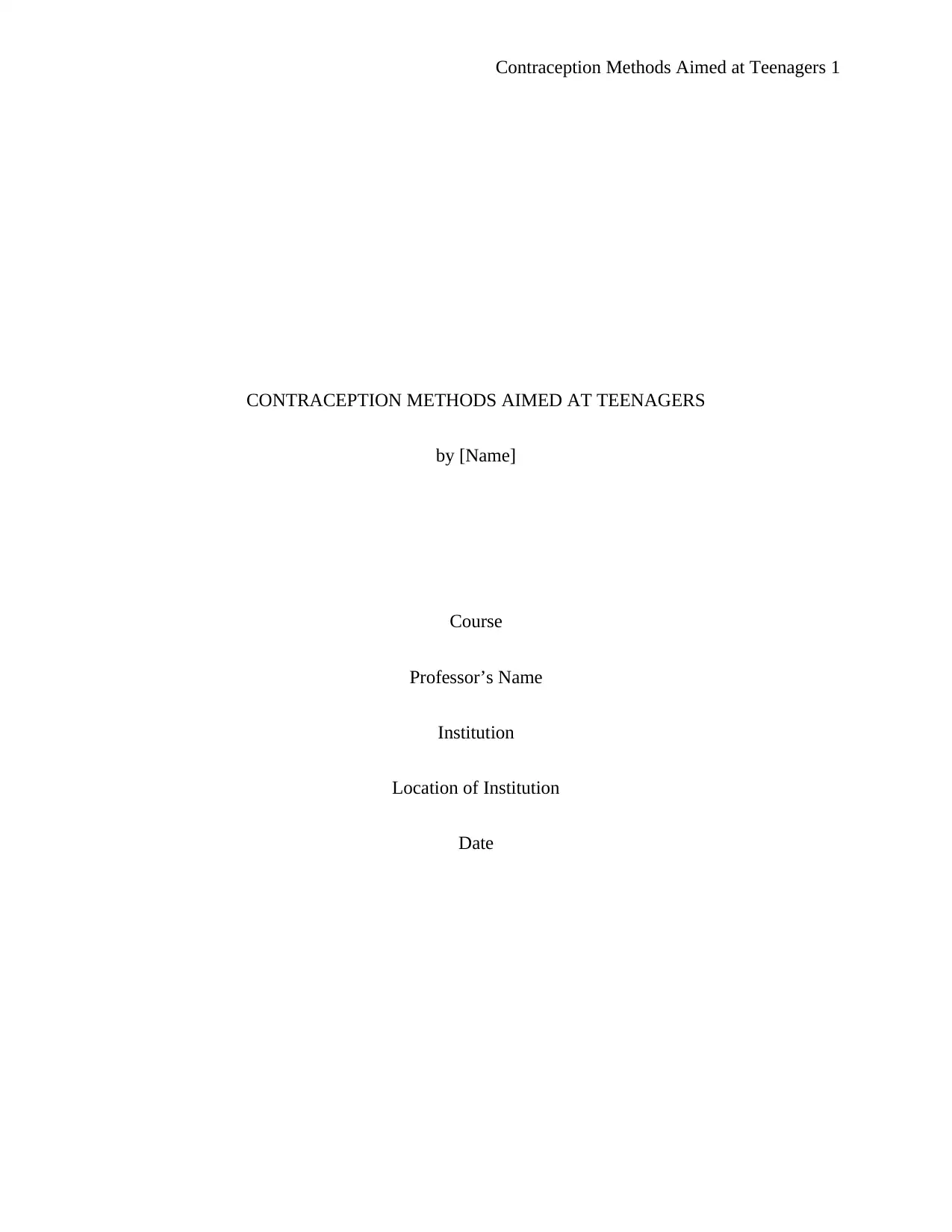
Contraception Methods Aimed at Teenagers 1
CONTRACEPTION METHODS AIMED AT TEENAGERS
by [Name]
Course
Professor’s Name
Institution
Location of Institution
Date
CONTRACEPTION METHODS AIMED AT TEENAGERS
by [Name]
Course
Professor’s Name
Institution
Location of Institution
Date
Paraphrase This Document
Need a fresh take? Get an instant paraphrase of this document with our AI Paraphraser
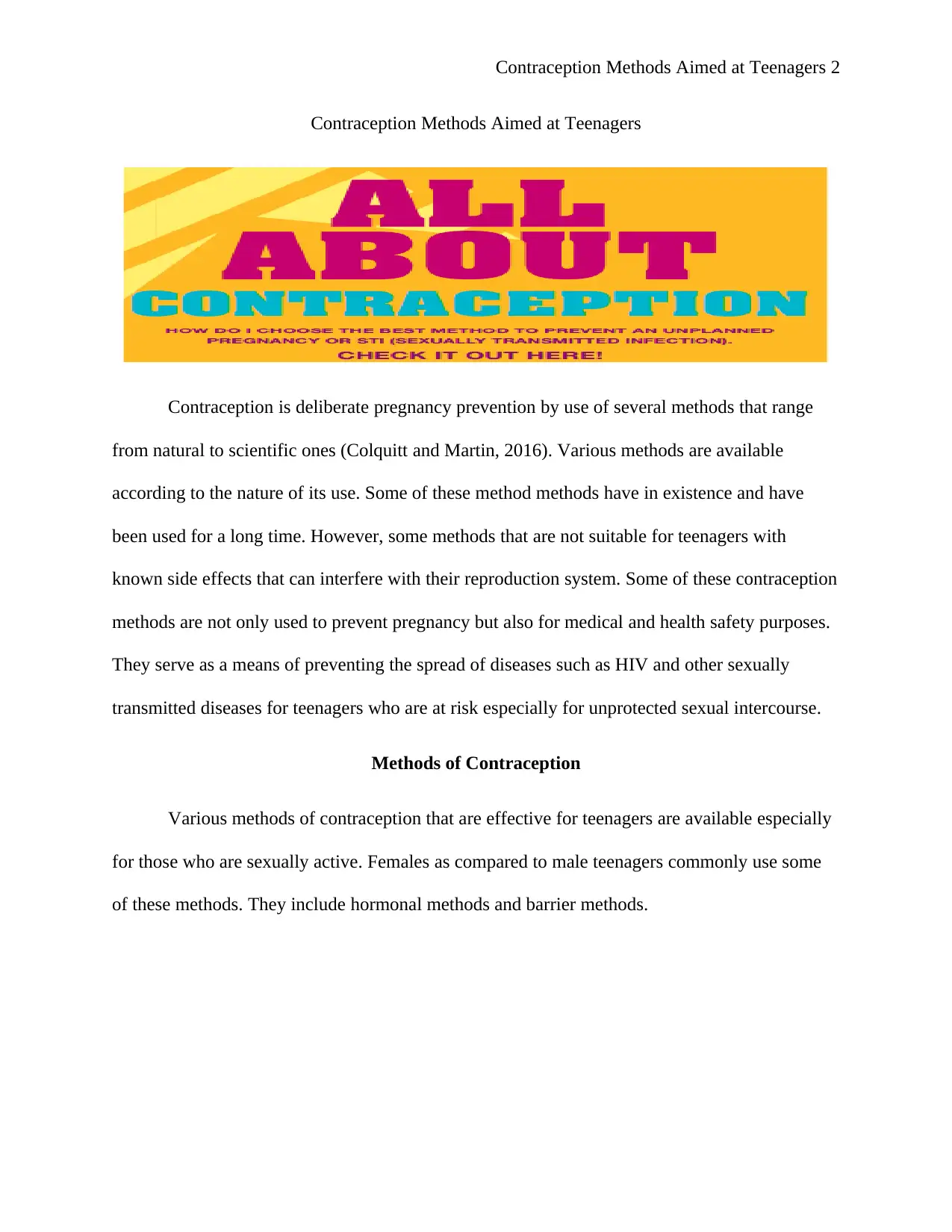
Contraception Methods Aimed at Teenagers 2
Contraception Methods Aimed at Teenagers
Contraception is deliberate pregnancy prevention by use of several methods that range
from natural to scientific ones (Colquitt and Martin, 2016). Various methods are available
according to the nature of its use. Some of these method methods have in existence and have
been used for a long time. However, some methods that are not suitable for teenagers with
known side effects that can interfere with their reproduction system. Some of these contraception
methods are not only used to prevent pregnancy but also for medical and health safety purposes.
They serve as a means of preventing the spread of diseases such as HIV and other sexually
transmitted diseases for teenagers who are at risk especially for unprotected sexual intercourse.
Methods of Contraception
Various methods of contraception that are effective for teenagers are available especially
for those who are sexually active. Females as compared to male teenagers commonly use some
of these methods. They include hormonal methods and barrier methods.
Contraception Methods Aimed at Teenagers
Contraception is deliberate pregnancy prevention by use of several methods that range
from natural to scientific ones (Colquitt and Martin, 2016). Various methods are available
according to the nature of its use. Some of these method methods have in existence and have
been used for a long time. However, some methods that are not suitable for teenagers with
known side effects that can interfere with their reproduction system. Some of these contraception
methods are not only used to prevent pregnancy but also for medical and health safety purposes.
They serve as a means of preventing the spread of diseases such as HIV and other sexually
transmitted diseases for teenagers who are at risk especially for unprotected sexual intercourse.
Methods of Contraception
Various methods of contraception that are effective for teenagers are available especially
for those who are sexually active. Females as compared to male teenagers commonly use some
of these methods. They include hormonal methods and barrier methods.
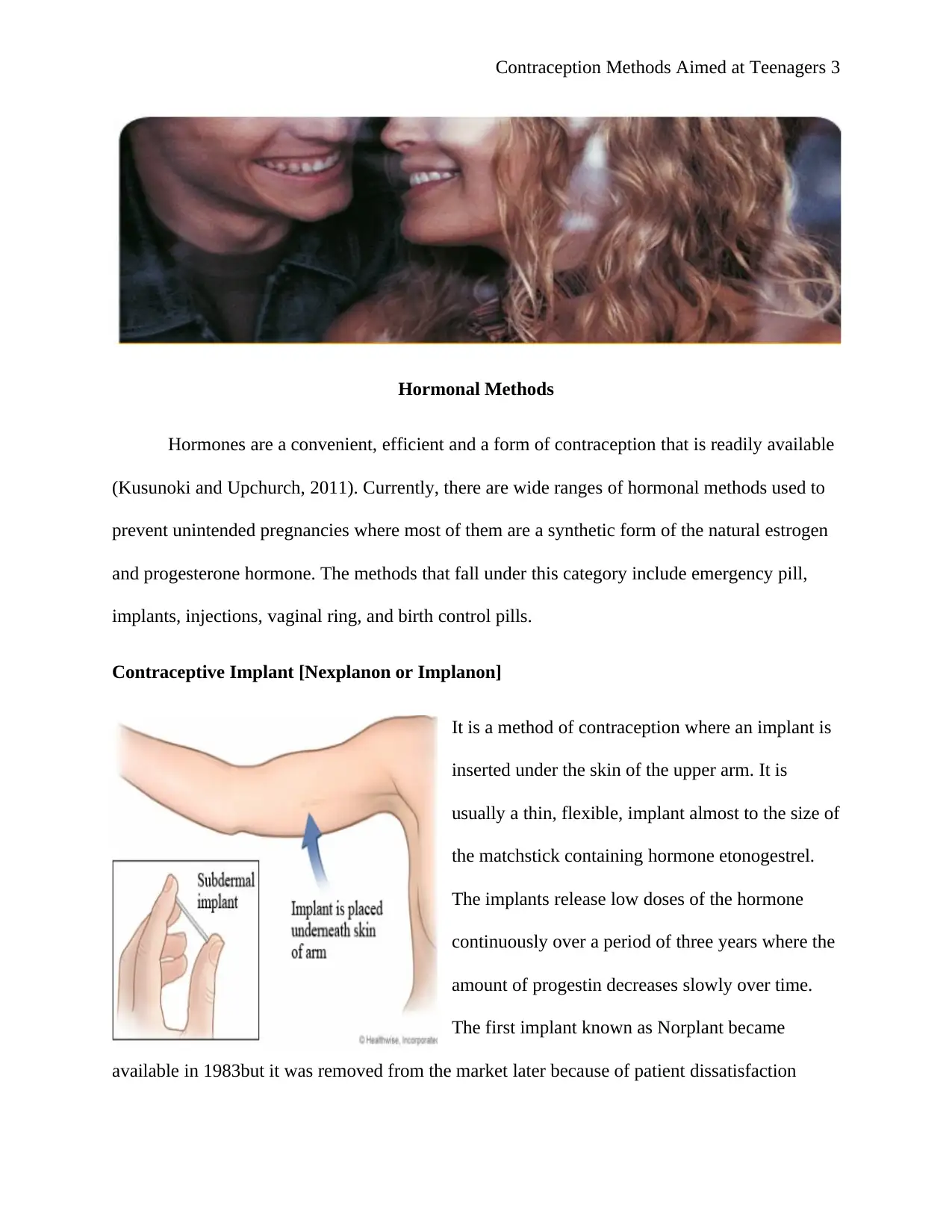
Contraception Methods Aimed at Teenagers 3
Hormonal Methods
Hormones are a convenient, efficient and a form of contraception that is readily available
(Kusunoki and Upchurch, 2011). Currently, there are wide ranges of hormonal methods used to
prevent unintended pregnancies where most of them are a synthetic form of the natural estrogen
and progesterone hormone. The methods that fall under this category include emergency pill,
implants, injections, vaginal ring, and birth control pills.
Contraceptive Implant [Nexplanon or Implanon]
It is a method of contraception where an implant is
inserted under the skin of the upper arm. It is
usually a thin, flexible, implant almost to the size of
the matchstick containing hormone etonogestrel.
The implants release low doses of the hormone
continuously over a period of three years where the
amount of progestin decreases slowly over time.
The first implant known as Norplant became
available in 1983but it was removed from the market later because of patient dissatisfaction
Hormonal Methods
Hormones are a convenient, efficient and a form of contraception that is readily available
(Kusunoki and Upchurch, 2011). Currently, there are wide ranges of hormonal methods used to
prevent unintended pregnancies where most of them are a synthetic form of the natural estrogen
and progesterone hormone. The methods that fall under this category include emergency pill,
implants, injections, vaginal ring, and birth control pills.
Contraceptive Implant [Nexplanon or Implanon]
It is a method of contraception where an implant is
inserted under the skin of the upper arm. It is
usually a thin, flexible, implant almost to the size of
the matchstick containing hormone etonogestrel.
The implants release low doses of the hormone
continuously over a period of three years where the
amount of progestin decreases slowly over time.
The first implant known as Norplant became
available in 1983but it was removed from the market later because of patient dissatisfaction
⊘ This is a preview!⊘
Do you want full access?
Subscribe today to unlock all pages.

Trusted by 1+ million students worldwide
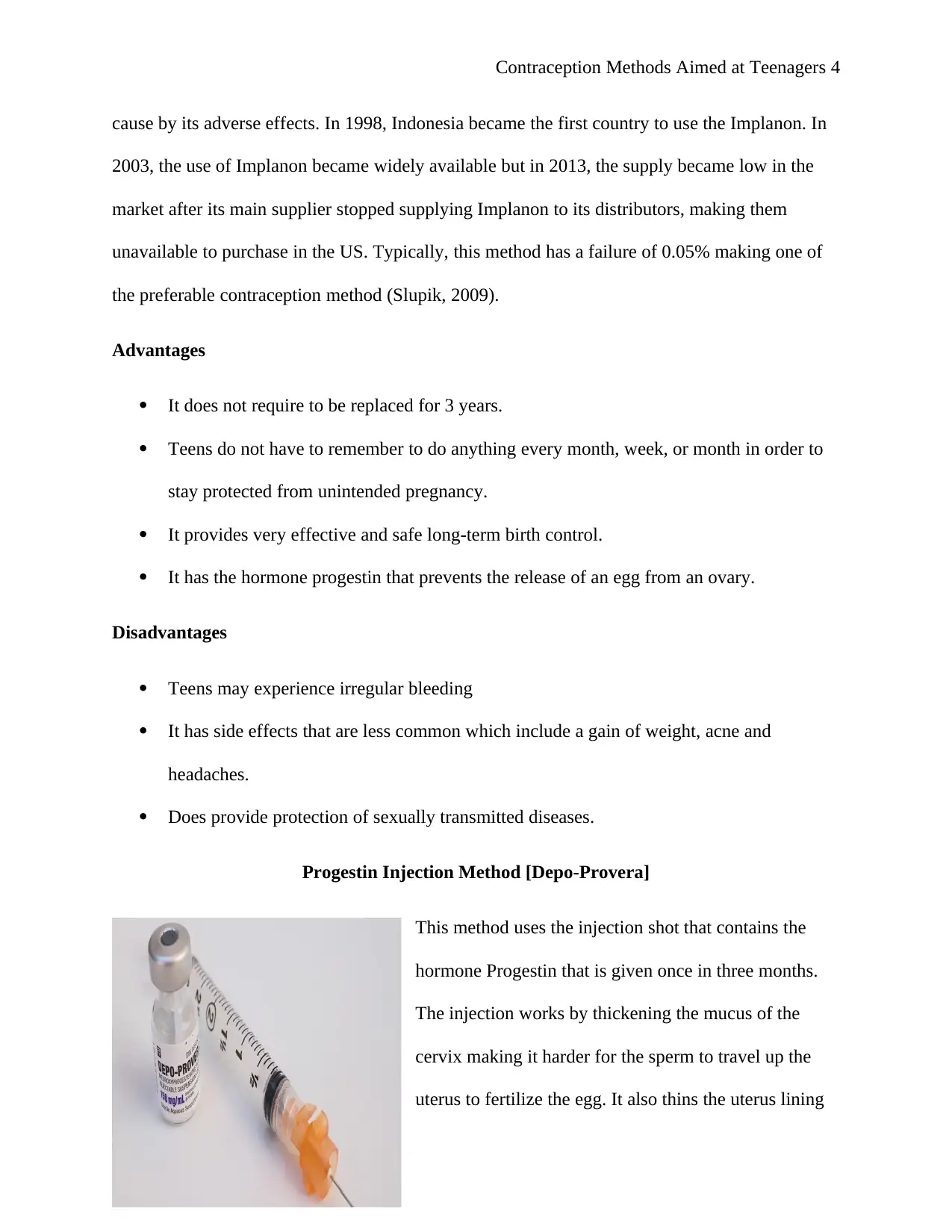
Contraception Methods Aimed at Teenagers 4
cause by its adverse effects. In 1998, Indonesia became the first country to use the Implanon. In
2003, the use of Implanon became widely available but in 2013, the supply became low in the
market after its main supplier stopped supplying Implanon to its distributors, making them
unavailable to purchase in the US. Typically, this method has a failure of 0.05% making one of
the preferable contraception method (Slupik, 2009).
Advantages
It does not require to be replaced for 3 years.
Teens do not have to remember to do anything every month, week, or month in order to
stay protected from unintended pregnancy.
It provides very effective and safe long-term birth control.
It has the hormone progestin that prevents the release of an egg from an ovary.
Disadvantages
Teens may experience irregular bleeding
It has side effects that are less common which include a gain of weight, acne and
headaches.
Does provide protection of sexually transmitted diseases.
Progestin Injection Method [Depo-Provera]
This method uses the injection shot that contains the
hormone Progestin that is given once in three months.
The injection works by thickening the mucus of the
cervix making it harder for the sperm to travel up the
uterus to fertilize the egg. It also thins the uterus lining
cause by its adverse effects. In 1998, Indonesia became the first country to use the Implanon. In
2003, the use of Implanon became widely available but in 2013, the supply became low in the
market after its main supplier stopped supplying Implanon to its distributors, making them
unavailable to purchase in the US. Typically, this method has a failure of 0.05% making one of
the preferable contraception method (Slupik, 2009).
Advantages
It does not require to be replaced for 3 years.
Teens do not have to remember to do anything every month, week, or month in order to
stay protected from unintended pregnancy.
It provides very effective and safe long-term birth control.
It has the hormone progestin that prevents the release of an egg from an ovary.
Disadvantages
Teens may experience irregular bleeding
It has side effects that are less common which include a gain of weight, acne and
headaches.
Does provide protection of sexually transmitted diseases.
Progestin Injection Method [Depo-Provera]
This method uses the injection shot that contains the
hormone Progestin that is given once in three months.
The injection works by thickening the mucus of the
cervix making it harder for the sperm to travel up the
uterus to fertilize the egg. It also thins the uterus lining
Paraphrase This Document
Need a fresh take? Get an instant paraphrase of this document with our AI Paraphraser
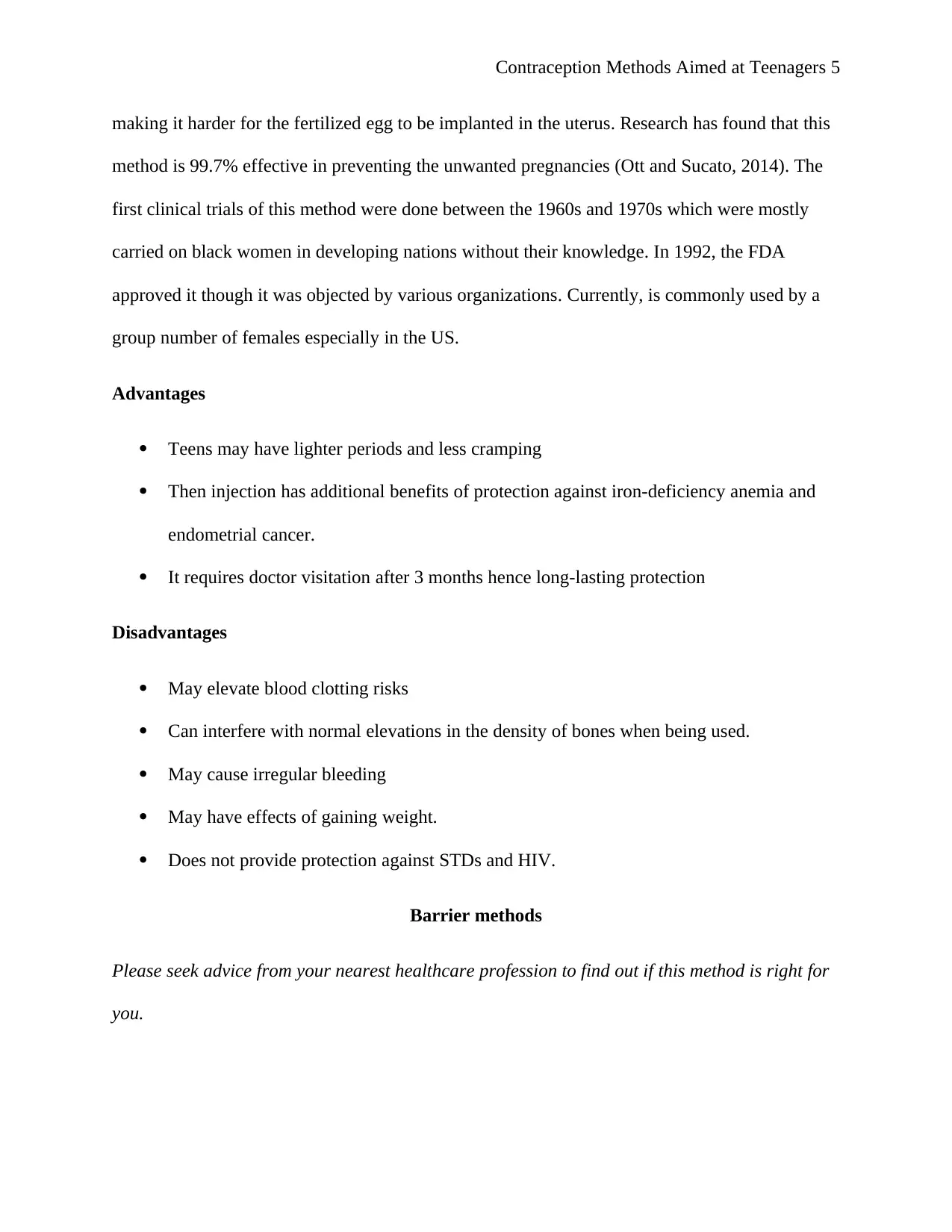
Contraception Methods Aimed at Teenagers 5
making it harder for the fertilized egg to be implanted in the uterus. Research has found that this
method is 99.7% effective in preventing the unwanted pregnancies (Ott and Sucato, 2014). The
first clinical trials of this method were done between the 1960s and 1970s which were mostly
carried on black women in developing nations without their knowledge. In 1992, the FDA
approved it though it was objected by various organizations. Currently, is commonly used by a
group number of females especially in the US.
Advantages
Teens may have lighter periods and less cramping
Then injection has additional benefits of protection against iron-deficiency anemia and
endometrial cancer.
It requires doctor visitation after 3 months hence long-lasting protection
Disadvantages
May elevate blood clotting risks
Can interfere with normal elevations in the density of bones when being used.
May cause irregular bleeding
May have effects of gaining weight.
Does not provide protection against STDs and HIV.
Barrier methods
Please seek advice from your nearest healthcare profession to find out if this method is right for
you.
making it harder for the fertilized egg to be implanted in the uterus. Research has found that this
method is 99.7% effective in preventing the unwanted pregnancies (Ott and Sucato, 2014). The
first clinical trials of this method were done between the 1960s and 1970s which were mostly
carried on black women in developing nations without their knowledge. In 1992, the FDA
approved it though it was objected by various organizations. Currently, is commonly used by a
group number of females especially in the US.
Advantages
Teens may have lighter periods and less cramping
Then injection has additional benefits of protection against iron-deficiency anemia and
endometrial cancer.
It requires doctor visitation after 3 months hence long-lasting protection
Disadvantages
May elevate blood clotting risks
Can interfere with normal elevations in the density of bones when being used.
May cause irregular bleeding
May have effects of gaining weight.
Does not provide protection against STDs and HIV.
Barrier methods
Please seek advice from your nearest healthcare profession to find out if this method is right for
you.
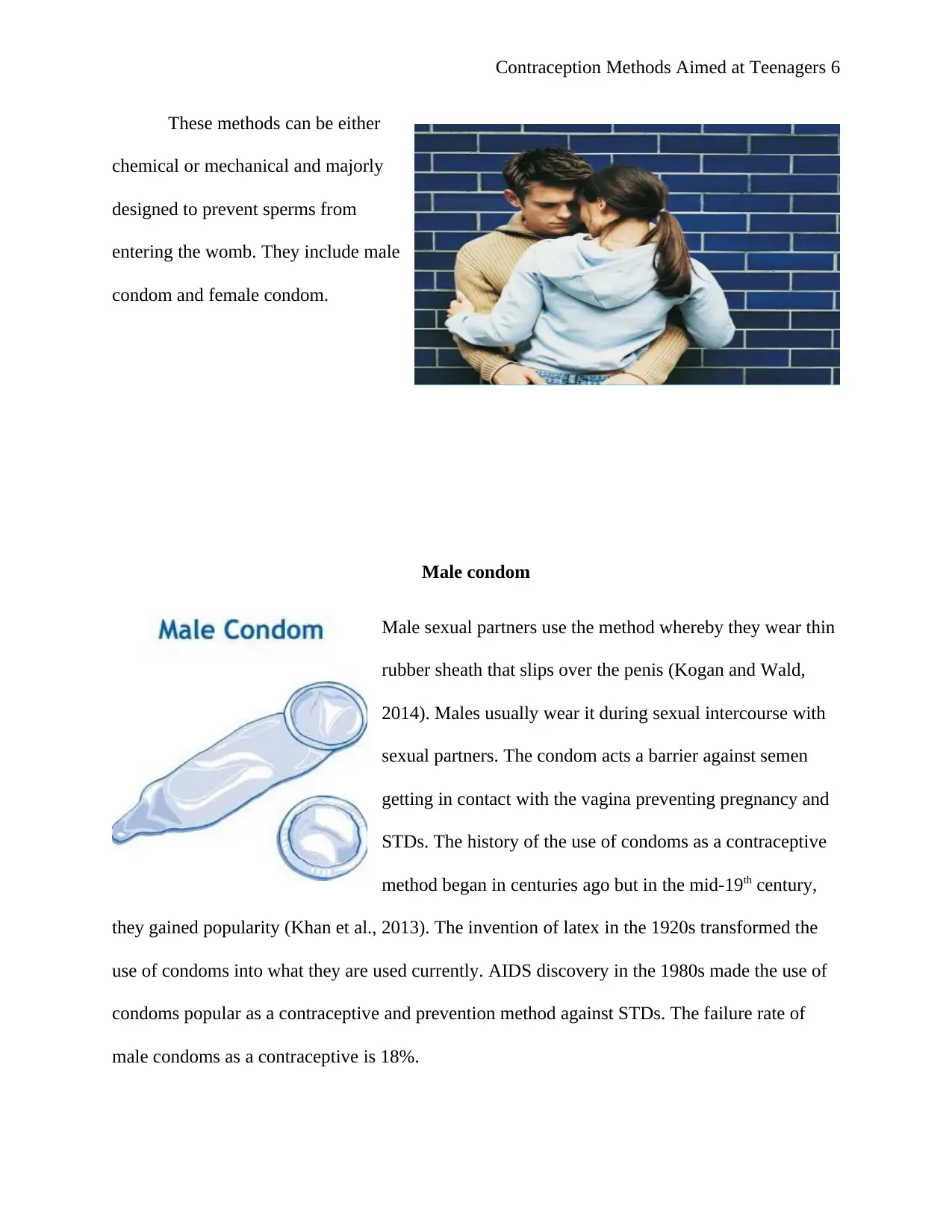
Contraception Methods Aimed at Teenagers 6
These methods can be either
chemical or mechanical and majorly
designed to prevent sperms from
entering the womb. They include male
condom and female condom.
Male condom
Male sexual partners use the method whereby they wear thin
rubber sheath that slips over the penis (Kogan and Wald,
2014). Males usually wear it during sexual intercourse with
sexual partners. The condom acts a barrier against semen
getting in contact with the vagina preventing pregnancy and
STDs. The history of the use of condoms as a contraceptive
method began in centuries ago but in the mid-19th century,
they gained popularity (Khan et al., 2013). The invention of latex in the 1920s transformed the
use of condoms into what they are used currently. AIDS discovery in the 1980s made the use of
condoms popular as a contraceptive and prevention method against STDs. The failure rate of
male condoms as a contraceptive is 18%.
These methods can be either
chemical or mechanical and majorly
designed to prevent sperms from
entering the womb. They include male
condom and female condom.
Male condom
Male sexual partners use the method whereby they wear thin
rubber sheath that slips over the penis (Kogan and Wald,
2014). Males usually wear it during sexual intercourse with
sexual partners. The condom acts a barrier against semen
getting in contact with the vagina preventing pregnancy and
STDs. The history of the use of condoms as a contraceptive
method began in centuries ago but in the mid-19th century,
they gained popularity (Khan et al., 2013). The invention of latex in the 1920s transformed the
use of condoms into what they are used currently. AIDS discovery in the 1980s made the use of
condoms popular as a contraceptive and prevention method against STDs. The failure rate of
male condoms as a contraceptive is 18%.
⊘ This is a preview!⊘
Do you want full access?
Subscribe today to unlock all pages.

Trusted by 1+ million students worldwide
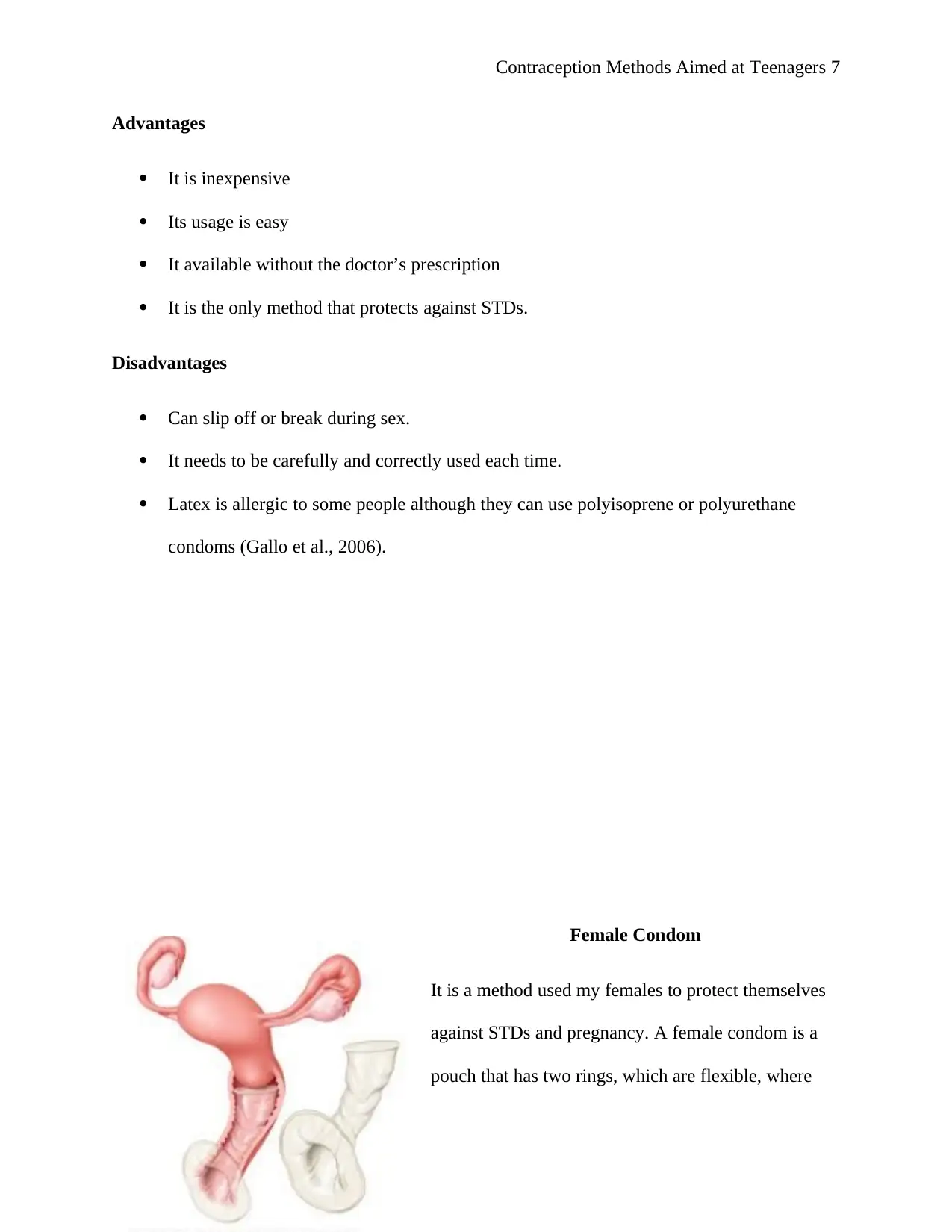
Contraception Methods Aimed at Teenagers 7
Advantages
It is inexpensive
Its usage is easy
It available without the doctor’s prescription
It is the only method that protects against STDs.
Disadvantages
Can slip off or break during sex.
It needs to be carefully and correctly used each time.
Latex is allergic to some people although they can use polyisoprene or polyurethane
condoms (Gallo et al., 2006).
Female Condom
It is a method used my females to protect themselves
against STDs and pregnancy. A female condom is a
pouch that has two rings, which are flexible, where
Advantages
It is inexpensive
Its usage is easy
It available without the doctor’s prescription
It is the only method that protects against STDs.
Disadvantages
Can slip off or break during sex.
It needs to be carefully and correctly used each time.
Latex is allergic to some people although they can use polyisoprene or polyurethane
condoms (Gallo et al., 2006).
Female Condom
It is a method used my females to protect themselves
against STDs and pregnancy. A female condom is a
pouch that has two rings, which are flexible, where
Paraphrase This Document
Need a fresh take? Get an instant paraphrase of this document with our AI Paraphraser
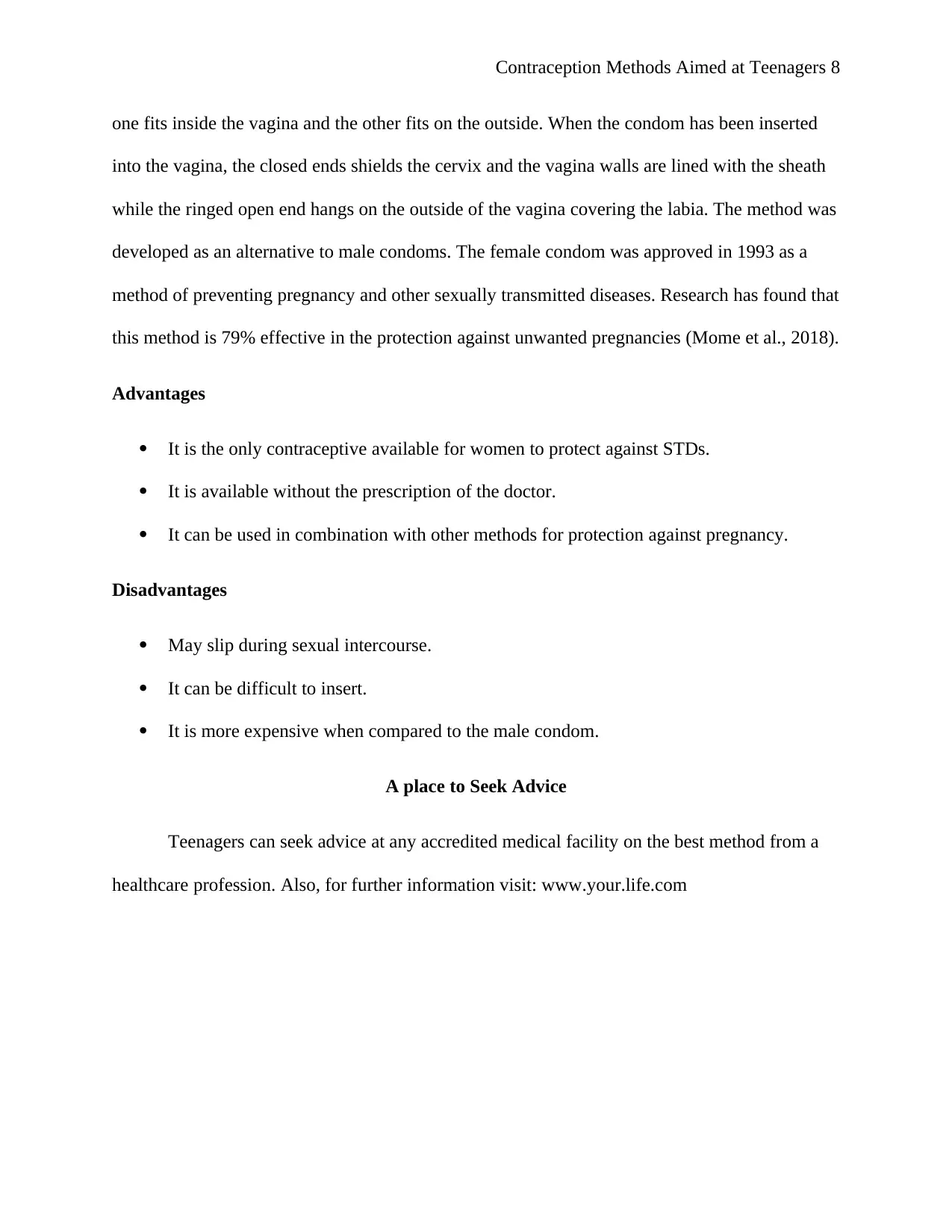
Contraception Methods Aimed at Teenagers 8
one fits inside the vagina and the other fits on the outside. When the condom has been inserted
into the vagina, the closed ends shields the cervix and the vagina walls are lined with the sheath
while the ringed open end hangs on the outside of the vagina covering the labia. The method was
developed as an alternative to male condoms. The female condom was approved in 1993 as a
method of preventing pregnancy and other sexually transmitted diseases. Research has found that
this method is 79% effective in the protection against unwanted pregnancies (Mome et al., 2018).
Advantages
It is the only contraceptive available for women to protect against STDs.
It is available without the prescription of the doctor.
It can be used in combination with other methods for protection against pregnancy.
Disadvantages
May slip during sexual intercourse.
It can be difficult to insert.
It is more expensive when compared to the male condom.
A place to Seek Advice
Teenagers can seek advice at any accredited medical facility on the best method from a
healthcare profession. Also, for further information visit: www.your.life.com
one fits inside the vagina and the other fits on the outside. When the condom has been inserted
into the vagina, the closed ends shields the cervix and the vagina walls are lined with the sheath
while the ringed open end hangs on the outside of the vagina covering the labia. The method was
developed as an alternative to male condoms. The female condom was approved in 1993 as a
method of preventing pregnancy and other sexually transmitted diseases. Research has found that
this method is 79% effective in the protection against unwanted pregnancies (Mome et al., 2018).
Advantages
It is the only contraceptive available for women to protect against STDs.
It is available without the prescription of the doctor.
It can be used in combination with other methods for protection against pregnancy.
Disadvantages
May slip during sexual intercourse.
It can be difficult to insert.
It is more expensive when compared to the male condom.
A place to Seek Advice
Teenagers can seek advice at any accredited medical facility on the best method from a
healthcare profession. Also, for further information visit: www.your.life.com
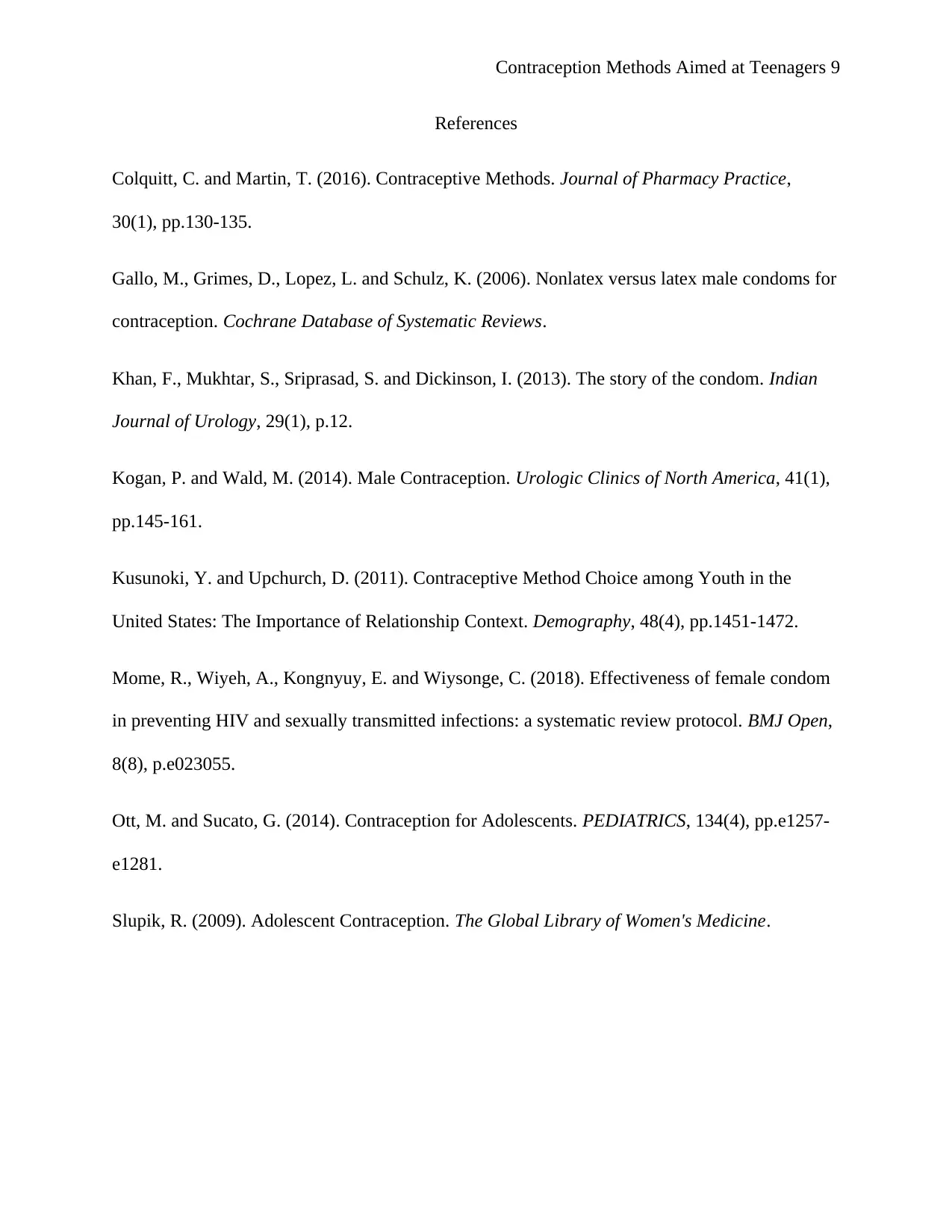
Contraception Methods Aimed at Teenagers 9
References
Colquitt, C. and Martin, T. (2016). Contraceptive Methods. Journal of Pharmacy Practice,
30(1), pp.130-135.
Gallo, M., Grimes, D., Lopez, L. and Schulz, K. (2006). Nonlatex versus latex male condoms for
contraception. Cochrane Database of Systematic Reviews.
Khan, F., Mukhtar, S., Sriprasad, S. and Dickinson, I. (2013). The story of the condom. Indian
Journal of Urology, 29(1), p.12.
Kogan, P. and Wald, M. (2014). Male Contraception. Urologic Clinics of North America, 41(1),
pp.145-161.
Kusunoki, Y. and Upchurch, D. (2011). Contraceptive Method Choice among Youth in the
United States: The Importance of Relationship Context. Demography, 48(4), pp.1451-1472.
Mome, R., Wiyeh, A., Kongnyuy, E. and Wiysonge, C. (2018). Effectiveness of female condom
in preventing HIV and sexually transmitted infections: a systematic review protocol. BMJ Open,
8(8), p.e023055.
Ott, M. and Sucato, G. (2014). Contraception for Adolescents. PEDIATRICS, 134(4), pp.e1257-
e1281.
Slupik, R. (2009). Adolescent Contraception. The Global Library of Women's Medicine.
References
Colquitt, C. and Martin, T. (2016). Contraceptive Methods. Journal of Pharmacy Practice,
30(1), pp.130-135.
Gallo, M., Grimes, D., Lopez, L. and Schulz, K. (2006). Nonlatex versus latex male condoms for
contraception. Cochrane Database of Systematic Reviews.
Khan, F., Mukhtar, S., Sriprasad, S. and Dickinson, I. (2013). The story of the condom. Indian
Journal of Urology, 29(1), p.12.
Kogan, P. and Wald, M. (2014). Male Contraception. Urologic Clinics of North America, 41(1),
pp.145-161.
Kusunoki, Y. and Upchurch, D. (2011). Contraceptive Method Choice among Youth in the
United States: The Importance of Relationship Context. Demography, 48(4), pp.1451-1472.
Mome, R., Wiyeh, A., Kongnyuy, E. and Wiysonge, C. (2018). Effectiveness of female condom
in preventing HIV and sexually transmitted infections: a systematic review protocol. BMJ Open,
8(8), p.e023055.
Ott, M. and Sucato, G. (2014). Contraception for Adolescents. PEDIATRICS, 134(4), pp.e1257-
e1281.
Slupik, R. (2009). Adolescent Contraception. The Global Library of Women's Medicine.
⊘ This is a preview!⊘
Do you want full access?
Subscribe today to unlock all pages.

Trusted by 1+ million students worldwide
1 out of 9
Related Documents
Your All-in-One AI-Powered Toolkit for Academic Success.
+13062052269
info@desklib.com
Available 24*7 on WhatsApp / Email
![[object Object]](/_next/static/media/star-bottom.7253800d.svg)
Unlock your academic potential
Copyright © 2020–2025 A2Z Services. All Rights Reserved. Developed and managed by ZUCOL.




